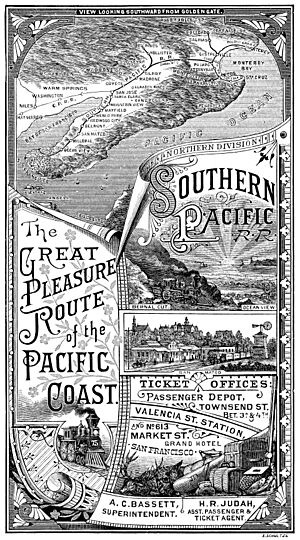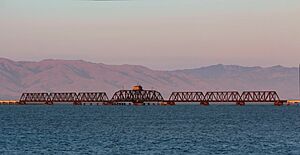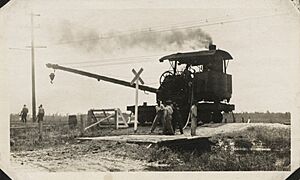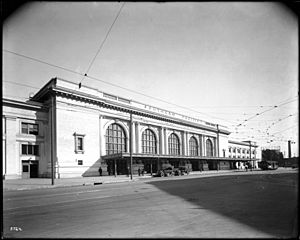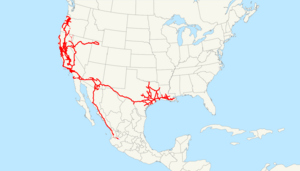History of the Southern Pacific facts for kids
The Southern Pacific (often called "SP") was a very important railroad company in the United States. Its history goes all the way from 1865 to 1998!
The Southern Pacific was actually three different companies over time. First, it was called the Southern Pacific Railroad. Then, it became the Southern Pacific Company. Finally, it was known as the Southern Pacific Transportation Company. Today, this last version of the Southern Pacific is part of the Union Pacific Railroad.
Contents
How the Southern Pacific Started
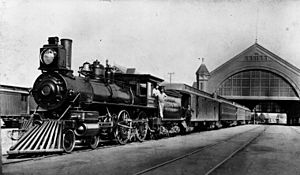
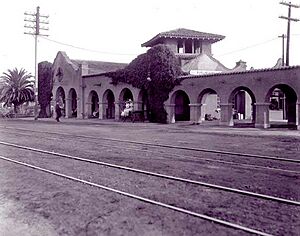

One of the very first railroads that became part of the Southern Pacific was the Galveston and Red River Railway (GRR). It was started in Texas on March 11, 1848. However, it didn't really get going until 1852. The goal was to build a railroad from Galveston Bay to the Red River.
Construction began in 1853. The GRR built about 2 miles (3.2 km) of track in Houston by 1855. More tracks were laid in 1856, and on September 1, 1856, the GRR changed its name to the Houston and Texas Central Railway (H&TC). The Southern Pacific bought the H&TC in 1883. It kept running on its own until 1927, when it was leased to another SP railroad, the Texas and New Orleans Railroad.
Another early railroad was the Buffalo Bayou, Brazos and Colorado Railway (BBB&C). It was started in Texas on February 11, 1850. The BBB&C was the very first railroad to start operating in Texas. It was also the first part of the Southern Pacific to begin running trains. Building started in 1851 between Houston and Alleyton, Texas. The first 20 miles (32 km) of track opened in August 1853.
Southern Pacific Railroad and Company
The first Southern Pacific company was created in San Francisco in 1865. A group of business people, led by Timothy Guy Phelps, wanted to build a rail line between San Francisco and San Diego, California.
In September 1868, a famous group of businessmen bought the company. They were known as the Big Four: Charles Crocker, Leland Stanford, Mark Hopkins, Jr., and C. P. Huntington. These same four men had also started the Central Pacific Railroad (CPRR) in 1861.
Key Moments for Southern Pacific
- June 1873: The Southern Pacific built its first train engine at its Sacramento workshops. It was a 4-4-0 type.
- November 8, 1874: Southern Pacific tracks reached Bakersfield, California. Work began on the famous Tehachapi Loop.
- September 5, 1876: The first train traveled all the way from San Francisco to Los Angeles, California. This was after the Tehachapi Loop was finished.
- 1877: Southern Pacific tracks from Los Angeles crossed the Colorado River at Yuma, Arizona. The Southern Pacific also bought the Houston and Texas Central Railway.
- 1879: Southern Pacific engineers started trying out the first train engines that ran on oil instead of coal.
- March 20, 1880: The first Southern Pacific train arrived in Tucson, Arizona.
- May 11, 1880: The Mussel Slough Tragedy happened in Hanford, California. This was a sad event involving a dispute over land rights with the railroad.
- May 19, 1881: Southern Pacific tracks reached El Paso, Texas. They got there before their rival, the Atchison, Topeka and Santa Fe Railway.
- January 12, 1883: The southern part of the second transcontinental railroad line was finished! Southern Pacific tracks from Los Angeles met the Galveston, Harrisburg and San Antonio Railway in Texas. This created the first all-weather, year-round railroad across the country.
- February 17, 1885: The Southern Pacific and Central Pacific railroads joined together under one main company called the Southern Pacific Company.
- April 1, 1885: The Southern Pacific took over all operations of the Central Pacific. The Central Pacific basically stopped existing as a separate company.
- 1886: The first refrigerator cars started running on the Southern Pacific. These special cars helped ship fresh fruits and vegetables, like oranges from Southern California, to the eastern United States. This helped the citrus industry grow a lot!
- 1886: Southern Pacific won an important case in the Supreme Court of the United States called Santa Clara County v. Southern Pacific Railroad. This case helped establish that corporations have equal rights under the law.
- 1898: Sunset magazine was started by the Southern Pacific to promote travel and tourism.
- 1901: The Union Pacific Railroad gained control of the Southern Pacific. For several years, SP trains and operations followed Union Pacific's ways.
- March 8, 1904: SP opened the Lucin Cutoff across the Great Salt Lake. This new route made the main line shorter and faster.
- April 18, 1906: The huge 1906 San Francisco earthquake hit, damaging the railroad's main office building.
- 1906: SP and UP together created the Pacific Fruit Express (PFE) company for refrigerator cars.
- 1910: The Dumbarton Rail Bridge, the first bridge to cross San Francisco Bay, was finished.
- 1913: The Supreme Court of the United States ordered the Union Pacific to sell all its shares in the Southern Pacific.
- 1914: Southern Pacific sold Sunset magazine.
- December 28, 1917: The U.S. government took control of American railroads to prepare for World War I.
- March 1, 1927: Many of SP's smaller railroads in Texas and Louisiana were leased to the Texas and New Orleans Railroad, which was also owned by SP.
- 1931: Automatic block signals were added to all Southern Pacific main lines. These signals helped trains stay safe and avoid collisions.
- April 14, 1932: The SP gained control of 87% of the Cotton Belt Railroad.
- May 1939: Passenger trains from Union Pacific, SP, and Santa Fe in Los Angeles all started using one big station, the Los Angeles Union Passenger Terminal.
- 1947: The first main diesel locomotives owned by SP started running. This meant the railroad was moving away from steam engines.
- 1951: Southern Pacific sold its Mexican railroad, the Southern Pacific of Mexico, to the Mexican government.
- 1952: A tough year for SP in California! A train called the City of San Francisco got stuck in heavy snow for three days. Also, the Kern County earthquake damaged the line over Tehachapi Loop.
- 1953: The first "piggyback" service started on the SP. This is when truck trailers are carried on flat train cars.
- January 1957: The last regular steam locomotives on the SP were retired. The railroad was now mostly using diesel engines.
- 1959: Southern Pacific moved more freight than any other U.S. railroad that year!
- November 1, 1961: The Texas and New Orleans Railroad (which included most of SP's Texas and Louisiana lines) officially merged with the Southern Pacific.
- 1965: The government rejected Southern Pacific's plan to take control of the Western Pacific Railroad.
- 1967: SP opened a long new section of railroad called the Palmdale Cutoff. This allowed trains to go through Cajon Pass and bypass Los Angeles.
Southern Pacific Transportation Company
The Southern Pacific Transportation Company (often called SPTC or SPT) was created in 1969. It took over from the older Southern Pacific Company. This new company became the final version of the Southern Pacific railroad.
Key Moments for SPTC
- May 1, 1971: Amtrak took over most long-distance passenger trains in the United States. After this, SP only ran local commuter trains between San Francisco and San Jose.
- 1972: Southern Pacific Communications started selling extra space on its communication network to other companies. This service later became part of Sprint!
- 1979: Southern Pacific bought a title insurance company called Ticor.
- 1980: Southern Pacific expanded its Cotton Belt line by buying part of another railroad.
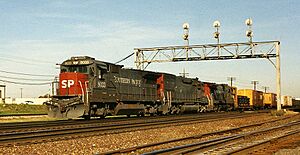
- 1982: Southern Pacific sold its communications business to GTE.
- 1984: The Southern Pacific Company merged with Santa Fe Industries to form a new company called Santa Fe Southern Pacific Corporation. However, the government did not allow the two railroads to merge. So, Southern Pacific Transportation Company was put up for sale.
- August 9, 1988: The government approved the sale of the Southern Pacific Transportation Company to Rio Grande Industries. This company also controlled the Denver and Rio Grande Western Railroad.
- October 13, 1988: Rio Grande Industries took control of the Southern Pacific. The two railroads operated together under the "Southern Pacific" name.
- 1989: Southern Pacific bought more tracks, allowing it to reach the Chicago area on its own rails for the first time.
- March 17, 1991: The Southern Pacific changed its look! It replaced its old lettering style with a new "Speed Lettering" design.
- 1992: The Northwestern Pacific Railroad officially merged into SP.
- 1996-1998: The Union Pacific Corporation bought the Southern Pacific Transportation Company. This was a big deal because Union Pacific had tried to buy SP almost a century before! Even though Union Pacific was the buyer, the Southern Pacific Transportation Company was the one that officially survived and then changed its name to Union Pacific Railroad. So, the former Southern Pacific Transportation Company became the current Union Pacific Railroad.
Morgan Line and the Sunset–Gulf Route
The Southern Pacific also had its own steamship lines, called the Morgan Line. These ships connected the western rail system through Galveston and New Orleans to New York City. This was part of their "Sunset—Gulf Route."
The ship service began with a small fleet owned by Charles Morgan. His ships sailed from Gulf ports and later to New York. The Southern Pacific bought this line and started offering service from the Pacific Coast to New York in 1883. By 1900, the Morgan Line ships were well-known in places like Cuba.
In 1912, a report said that Southern Pacific's "Sunset—Gulf Route" was special because it was the only railroad that controlled a route between the Atlantic and Pacific coasts. This allowed SP to compete strongly for cargo and passengers traveling across the country.
Many of the line's new ships were built by a new shipyard that later became Newport News Shipbuilding. During wars, like the Spanish–American War, the Navy often took these ships for military use. This meant SP had to build new ships or lease others to keep its service going. By 1921, the fleet included many passenger ships, freighters, and even tank ships.
Ferry Service
The Central Pacific Railroad, and later the Southern Pacific, had a large fleet of ferry boats. These ferries connected Oakland with San Francisco across the water. They built a huge pier called the Oakland Long Wharf in the 1870s for both local and long-distance passengers. The Central Pacific bought almost all the land along the Oakland waterfront, which gave them a lot of control over the area.
By 1930, the Southern Pacific owned the world's largest ferry fleet! They carried 40 million passengers and 60 million vehicles every year on 43 different boats. Southern Pacific also had ferry service across the Mississippi River in Louisiana.
However, when big bridges like the Huey P. Long Bridge (1935) and the San Francisco–Oakland Bay Bridge (1936) opened, people didn't need ferries as much. By 1951, only 6 ships were still active. Southern Pacific stopped its Mississippi River ferry service by 1953, and all SP ferry service ended in 1958.
Images for kids
-
Former Southern Pacific railway caboose on display in Flatonia, Texas.


